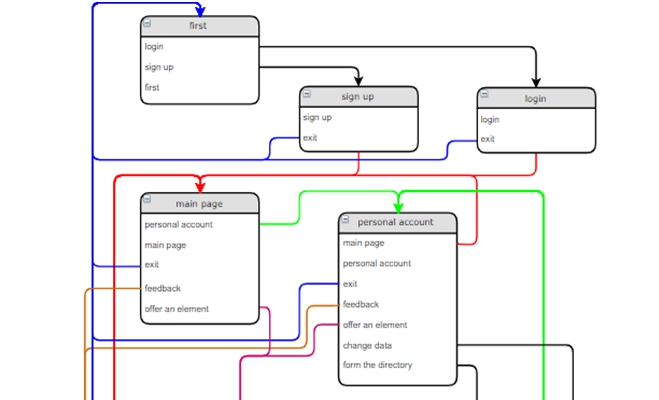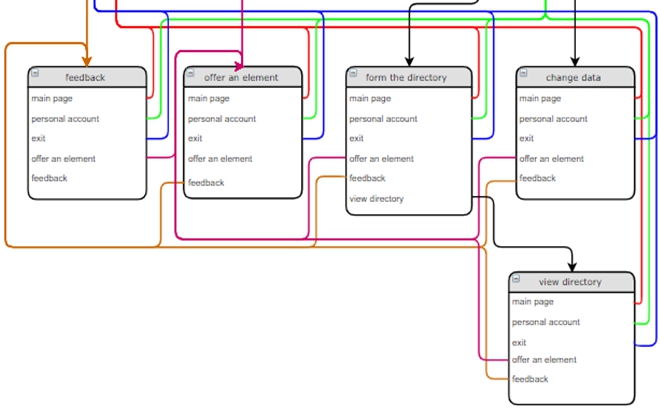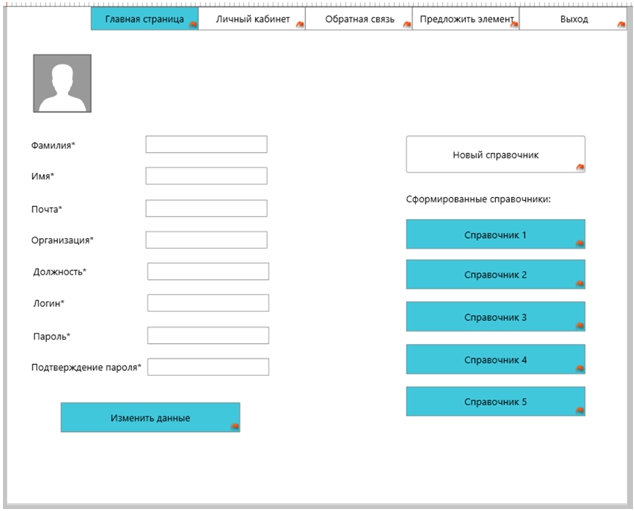МЕТОДЫ РАЗРАБОТКИ ВЕБ-ПРИЛОЖЕНИЯ ДЛЯ ХРАНЕНИЯ ДАННЫХ О НАДЕЖНОСТИ
МЕТОДЫ РАЗРАБОТКИ ВЕБ-ПРИЛОЖЕНИЯ ДЛЯ ХРАНЕНИЯ ДАННЫХ О НАДЕЖНОСТИ
Научная статья
Файдрахманов Р.В.1, *, Файдрахманова Г.Ф.2
1 ORCID: 0000-0002-9513-6511;
2 ORCID: 0000-0003-0409-3833;
1 Национальный исследовательский университет «Высшая школа экономики», Москва, Россия;
2 Башкирский государственный университет, Нефтекамский филиал, Нефтекамск, Россия
* Корреспондирующий автор (rusya1001[at]yandex.ru)
АннотацияНа данный момент в современном мире возрастают требования к электронному оборудованию, так как оно играет важную роль в жизни человека. Для производства качественных систем необходимо правильно определять надежность каждого элемента продукта, но это очень трудно сделать из-за рассредоточения информации, а в некоторых случаях и ее отсутствии в доступных источниках. Статья направлен на обзор методов создание веб приложения, в котором будет содержаться база данных с информацией о надежности вычислительных систем и телекоммуникационного оборудования.
Ключевые слова: компьютерные системы и телекоммуникационное оборудование; MTBF; веб-приложение; база данных; методы.
METHODS FOR DEVELOPING A WEB APPLICATION TO STORE DATA ABOUT RELIABILITY
Research article
Faidrakhmanov R.V.1, *, Faydrakhmanova G.F.2
1 ORCID: 0000-0002-9513-6511;
2 ORCID: 0000-0003-0409-3833;
1 National Research University “Higher School of Economics”, Moscow, Russia;
2 Bashkir state University, Neftekamsk branch, Neftekamsk, Russia
* Corresponding author (rusya1001[at]yandex.ru)
AbstractAt the moment, in the modern world there are increasing requirements for electronic equipment, as it plays an important role in human life. To produce quality systems, it is necessary to correctly determine the reliability of each element of the product, but it may be very difficult to do because of the dispersion of information and in some cases its absence from available sources. The article aims to review the methods of creating a web application that will contain a database with information about the reliability of computer systems and telecommunications equipment.
Keywords: computer system and telecommunications equipment; MTBF; web application; database; methods.
Introduction
Currently, electronic equipment plays an important role in human life, every day the requirements for devices are becoming stricter due to the increasing human needs, and the quality of the equipment depends directly on its components, in other words, in some systems, the using of low-quality components is unacceptable. Therefore, there is a problem of choosing high-quality products for computer systems and telecommunication equipment, in addition, the correct choice of components becomes difficult due to the lack of a single repository of information, and in some cases, its absence.
The main purpose of the study is to create a web application based on a database containing data on the reliability of computer systems and telecommunications equipment.
The development of a reliability guide will be useful for developers and designers of electronic equipment. Each enterprise to produce computer systems and telecommunications equipment will be able to use the data from the directory for the selection of elements with the required characteristics, thereby improving the quality of products.
Literature review
The literature review is focused on articles containing information about the reliability of equipment and systems. Below can be found the articles on topics such as mean time to failure, failure rate modeling using reliability data, cost optimization, database normalization and web application development frameworks (Torell W. et al in 2004, Brown E. et al in 2004, Hsieh C.C. et al in 2001, Kent W. in 1982, Plekhanova J. et al in 2009).
In the article “Mean time between failure: explanation and standards” written by Torell W. and Avelar V. in 2004, it became clear to the authors that the search for the mean time between failure (MTBF) is very difficult [1]. It is hard not to agree with the authors that there is an infinite number of definitions of the concept of failure. According to Torell W. and Avelar V., there are two main conditions: (1) the product completely ceases to perform its functions, (2) the failure of a single component of the product, while the product continues to perform its functions. In the article, the authors show the formula for finding reliability and availability through MTBF and mean time to restoration (MTTR). Torell W. and Avelar V. are sure that for the correct assessment of MTBF it is necessary to apply an individual approach for each case. The article shows the methods forecasting of MTBF such as MIL-HDBK 217, Telcordia, HRD5, RBD (Reliability Block Diagram), Markov Model, FMEA / FMECA, Fault Tree, HALT and reliability estimation methods such as similar item prediction or field data measurement. To summarize, the authors conclude that the most important thing about finding the mean time between failure is an understanding of the work and a correct definition of a cause of failure of a device or a system.
The key feature of the article “Failure rate modeling using equipment inspection data” (Brown R.E., 2004) is the use of control data of the equipment for customizing failure rates by a new method [2]. The authors assume that this method allows displaying data that can make calibration based on interruption distribution. To solve the problem of system failures, the authors admit that for each class of equipment it is necessary to characterize the level of failure rate, paying attention to critical parameters. In addition, in the article, the authors describe how to use the classes after the measurements are done. Summarizing the work, the developed model of failure rate shows that failure rates of different equipment are different too. It is easy to agree that the model adds fundamental features for reliability modeling.
The main idea of Reliability and cost optimization in distributed computing systems is that system value and level of hardware redundancy are interconnected [3]. Hsieh C.C. and Hsieh Y.C. consider that distributed computing systems do not consist of cycles (Hsieh C. C., Hsieh Y. C., 2001). They are sure that those computing systems that aimed to success, must be reliable as well. Therefore, they distinguish three stages to achieve the system´s reliability. As a result of this study hardware redundancy policies and task, the allocation was considered. An important achievement of the authors is that they found that while increasing the redundancy level of the system, the cost may either increase or it is unimodal. As it can be expected the algorithm that was used in the article helps to reduce the cost of the system, with the optimal distribution of tasks and hardware redundancy level.
To sum the data reliability of computer systems and telecommunications equipment it is necessary to create a database and while building one, it is important to follow certain rules. In the article “A simple guide to five normal forms in relational database theory” by Kent W. considers database normalization (Kent W., 1982) [4]. Development rules and normalization rules of a database are designed to prevent data inconsistencies and update anomalies. In the article, the researcher highlights five normal forms, where the first one excludes the repeated fields of the variable. The second and third normal forms establish relations between the key and non-key fields, and the fourth and fifth normal forms deal with multi-valued facts (“many-to-one” and “many-to-many”). Kent W. believes that this approach helps to normalize the database, at the same time the author considers that the method does not take into account all the nuances that may arise in the design of the database.
Using all the data on reliability it is necessary to make a web application. In the article “Evaluating web development frameworks: Django, Ruby on Rails and CakePHP” (Plekhanova J., 2009) the authors give arguments for and against about which framework is best for developing a web application [5]. In this article, the authors describe such frameworks for creating web applications as Django, Ruby on Rails and CakePHP. It is important that the researchers evaluate each framework, but do not give an answer about which one is better. They believe that each of the frameworks is suitable for a different task. The main advantages of Django are simple templates and automatically generated administrative interface. To implement the project, the Django framework was chosen together with the JavaScript programming language [6, 7].
The reviewed works will form the foundation for the future study by providing a clearer understanding of the research topic, for example, when developing methods.
Methods
For achieving the goal of the project, it is necessary to highlight top three stages of the research: database design, information gathering, and web application development, it is important to stick to the to-do list that was marked before. First, it is necessary to analyze the subject area, for this, it is needful to go through the technical specifications, respectively the data of the future database [8]. The second stage essential is to run the conceptual design, where it is needed to certain the whole database and its connections. The next step is followed by applying the logical design, in which the data redundancy is removed with a help of normalization and finally, the physical design of the database. While gathering the information of reliability of computer systems and telecommunication equipment it is required to use the methods of making requests in the Web and manual. The data processing requires the following operations:
- data formalization, for uploading it to the database,
- data sorting, for definition those to the given class, group and subgroup of the database,
- data converting using the mathematics formulas [9, 10].
Web application development requires the following operations:
- definition of purposes and tasks, that should be solved by using the application,
- design using UML diagrams to describe and portray the website,
- development of the structure of the site, where the sitemap and page frames are defined,
- development of the design layout, for working with the visual concept of the website,
- turning the graphic design into the HTML-layout and testing this,
- the process of programming, at this stage the most important task is to build the functional tools for filing and processing the data.
The Django framework (Python programming language) was chosen after reviewing the literature. To describe the pages are used HTML, CSS. JavaScript, the JQuery library are used to get dynamic generated pages.
When following all items, the results described in the next paragraph will be obtained.
Results anticipated
If the methods are used correctly, at the end of the project there will be four main points:
- database design,
- data collection and structuring of the reliability of computer systems and telecommunication equipment,
- web application development, which is needed to access the database,
The database will consist of entities: main, classes, groups, subgroups, company. In the main spreadsheet, there are fields with a name of the equipment, class, group, subgroup, the value of reliability, link to the information source and the date of the first mention in the list. The summed database, which was built using resources such as Network, same references (similar manuals), scientific literature must be distributed through the groups, all the calculations must have the same form. When missing the information, it is necessary to mark it.
The conceptual diagram of the web application is shown in picture one, which can best figure the structure of the site, where you can see the pages of the site, as well as the link between the pages. The first page contains basic information about the site and buttons for login and registration. After login or registration, it is possible to go to the personal account and to form a Handbook that contains elements of a reliability. It is also possible for users to offer their elements and get contact to administrator in. While searching for a required piece of the database, it is important for the user to be able to use the filters to make the search process easier. The web application should have a user-friendly interface.
Fig. 1 – Conceptual diagram of a web application
Figure two shows a designed “Personal account” page that shows how the page look like. Page is modeled in the program “Mockplus”. There is a pinned menu at the top of the page that is fixed on all pages of the site. It also shows basic information about user, a button to add a directory.
Fig. 2 – designed page “Personal account”
Conclusions
This topic is very relevant now, many companies in the field of development of various equipment need a reference book on the reliability of computer systems and telecommunications equipment. This development, when used correctly, will improve the work for companies, as well as ensure the development of more reliable electronic systems. For the successful implementation of the project, it is necessary to adhere to the methods for such tasks as database development, information collection and development of the web application described above, as well as to rely on the considered sources of information. It is important to understand how it is necessary to maintain the system for proper functioning in the future.
| Конфликт интересов Не указан. | Conflict of Interest None declared. |
Список литературы / References
- Torell W. Mean time between failure: explanation and standards / W. Torell, V. Avelar // white paper, 2004
- Brown R. E. Failure rate modeling using equipment inspection data, / R. E. Brown // Power Engineering Society General Meeting, 2004
- Hsieh Y.C. Reliability and cost optimization in distributed computing systems, / C. C. Hsieh, Y.C. Hsieh // Computers & Operations Research, 2003
- Kent W. A simple guide to five normal forms in relational database theory / W. Kent // Communications of the ACM, 1983
- Plekhanova J. Evaluating web development frameworks: Django, Ruby on Rails and CakePHP / J. Plekhanova // Institute for Business and Information Technology, 2009
- Плюсы и минусы Django [Электронный ресурс] URL: https://python-scripts.com/django-obzor (дата обращения 01.04.2018)
- Руководство по Django [Электронный ресурс] URL: https://metanit.com/python/django/ (дата обращения 03.04.2018)
- Наумов А. Н. Системы управления базами данных и знаний / А. Н. Наумов, А. М. Вендров, В. К. Иванов – М.: Финансы и статистика, 1991. – 352 с.
- Гарсиа-Молина Г. Системы баз данных. Полный курс / Г. Гарсиа-Молина, Д. Ульман, Д. Уидом. – М.: Издательский дом "Вильямс", 2003. – 1088 с.
- Проектирование баз данных. Нормализация [Электронный ресурс] URL: https://club.shelek.ru/viewart.php?id=311 (дата обращения 05.04.2018)
Список литературы на английском языке / References in English
- Torell W. Mean time between failure: explanation and standards / W. Torell, V. Avelar // white paper, 2004
- Brown R. E. Failure rate modeling using equipment inspection data, / R. E. Brown // Power Engineering Society General Meeting, 2004
- Hsieh Y.C. Reliability and cost optimization in distributed computing systems, / C. C. Hsieh, Y.C. Hsieh // Computers & Operations Research, 2003
- Kent W. A simple guide to five normal forms in relational database theory / W. Kent // Communications of the ACM, 1983
- Plekhanova J. Evaluating web development frameworks: Django, Ruby on Rails and CakePHP / J. Plekhanova // Institute for Business and Information Technology, 2009
- Plyusy i minusy Django [Pros and cons of Django] [Electronic resource] URL: https://python-scripts.com/django-obzor (accessed: 01.04.2018). [in Russian]
- Rukovodstvo po Django [Guide to Django] [Electronic resource] URL: https://metanit.com/python/django/ (accessed: 03.04.2018). [in Russian]
- Naumov A. N. Ivanov Sistemy upravleniya bazami dannyh i znanij [Database and knowledge management systems] / A. N. Naumov, A. M. Vendrov, V. K. – M.: Finansy i statistika, 1991. – 352 p. [in Russian]
- Garcia-Molina G. Sistemy baz dannyh. Polnyj kurs [Database system. Full course] / G. Garcia-Molina, J. Ullman, J. Widom. – M.: Publishing house "Vil'yams", 2003. – 108 p. [in Russian]
- Proektirovanie baz dannyh. Normalizaciya [Database design. Normalization] [Electronic resource] URL: https://club.shelek.ru/viewart.php?id=311 (accessed: 05.04.2018). [in Russian]



